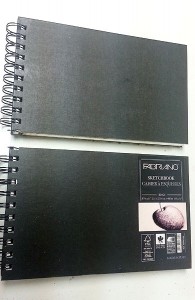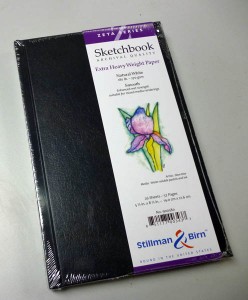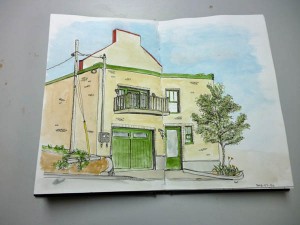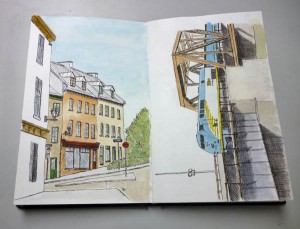I’m a lucky guy. Laure Ferlita reads my blog. If you don’t know Laure, she is a VERY talented artist/sketcher whose work I admire a lot. She has her own blog and left a comment on my recent post about Stillman & Birn sketchbooks where she advocates the use of what she calls a ‘junk journal.’ You can, and should, read her blog post, titled “Pen Practice In My Junk Journal” on this subject.
In that post Laure advocates the use of a ‘junk journal’, a sketchbook that may be a cast off from buying an inadequate sketchbook, or maybe even bought as a ‘junk journal.’ While the name Laure gives to these sketchbooks comes from the notion that they might be otherwise thrown away, they are anything but junk, but rather a liberating and fun tool. A junk journal, in my view, is a crucial part of a newbie’s arsenal. While Laure, an accomplished artist, uses it to gain unfettered creativity in planning, playing, and enjoying her skills. I think we newbies have an additional use for it, which is that we’re trying to figure out how to do stuff and a junk journal is the best place to do it in my view.
For myself, I have a ‘junk journal’, though it isn’t one of my rejects. Instead, it’s a 9×12 Stillman & Birn Epsilon sketchbook that sits, open on my desk, all the time. It’s where I do tests of new materials. It’s where I try to replicate a technique or idea I’ve gleaned from the many bright folks that inhabit the Internet. It’s where I try to improve my drawing and painting techniques. This sketchbook is crucial to my learning process as I feel the notion of learning by doing is a good one, there are different kinds of doing and separating my ‘learning’ (junk journal) from my ‘doing’ (creating the best sketch I can) helps me a lot.

Here I was trying to figure out how to draw cylinders, with a bit of 'quick building' thrown in for good measure.
When one tries to learn piano one doesn’t just try to play a Chopin sonata over and over again. One plays scales, plays Chopsticks, Twinkle-Twinkle-Little-Star or whatever. In short, if sketching buildings (my thing) is what you like, you don’t want to mess up a nice sketch of a building trying to figure out how to indicate snow against its wall. You need a ‘junk journal’ to figure out that 1) drawing a line to indicate snow is a bad idea, 2) that negative painting that snow line is far superior and 3) get some practice doing it in small, insignificant vignette sketches.
I’ve made it pretty clear in my S&B post that I’m an advocate of using first class paper all the time. I tried to indicate how little more it costs to do so in that post. But I think Laure’s views on a junk journal and mine are not so different. Rather, I think there are two components to ‘junk journal’ and they should be addressed separately. They are:
1) You need a sketchbook where you can play, with no expectations of drawing anything you’re going to frame or post on the Internet – the junk journal that Laure advocates.
2) You need to decide whether you need cheap paper to be liberated as in 1) or not.
I think, without a doubt, Laure is right about the first thing for all the reasons she argues on her blog AND as I’ve just argued, it’s probably more important for new sketchers to have such a sketchbook.

Here I was responding to ideas from Artist's Journal Workshop on how to paint kitchen wall tiles and bricks, with some paint smears and smudges that I can't explain.
For the second thing, however, I think it’s not so clear. While Laure’s idea of using an existing, and rejected sketchbook seems very logical, and certainly frugal, it was afterall, a rejected sketchbook. You’ve said, “Yuck!” for a reason. And if your junk journal is to be used to try new techniques, experiment with ideas, and generally aid in your learning the craft, wouldn’t it be better if the paper in that sketchbook be of a quality similar to what you use when you actually do a so-called ‘serious’ sketch or journal entry?
Of course this is true so the big problem is whether you can get past the notion that paying an extra few cents for a blank page on which to scribble is a good idea.
I find that by using a first class sketchbook is worth it to me because I’m testing techniques, not just ideas. Further by using much larger journal than my carry-everywhere sketchbooks I cut the cost of the play even more. I scatter experiments and sketches over a 8 1/2 x 11 page, done in the size I’d do in my normal sketchbooks, and I can fit 4-6 ideas on a page, sometimes more. I’m not trying to produce a ‘real’ sketch, remember. And so, while my large S&B Epsilon costs $22, there are 100 pages on which I can doodle/test/sketch and even at four ideas per page it’s only costing me a nickel per idea. Pretty cheap to have the knowledge that the paper won’t bleed, buckle and that anything learned will translate well to my ‘real’ sketchbooks.
In summary, following Laure’s recommendation is probably the most important thing a newbie sketcher can do to help develop technique and style. Whether it is ideally done on cheap paper, is, however, more a function of getting past the notion that you’re worth a few nickles (grin).
And now I’ve done something I thought I’d never do – show people pages from my junk journal. I feel like Hagrid, in the Philosopher’s Stone movie when he kept giving privileged info to the kids, followed with “I shouldn’t have told you that.”













